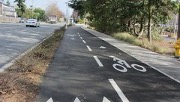This case study is part of the Federal Highway Administration toolkit on innovative finance strategies to accelerate bicycle and pedestrian project delivery, a reference for local and state transportation agencies. The Seattle Children's Hospital funded the Livable Streets Initiative, a series of transportation improvements in northeast Seattle, Washington.

In 2007, the Seattle Children's Hospital (SCH) announced a major hospital expansion that would more than double the size of the campus over the course of 20 years. Anticipating that this expansion would impact transportation in the area, SCH began to work with the community to explore ways to improve multimodal mobility. In 2010, SCH launched the Livable Streets Initiative and committed nearly $4 million to transportation projects over the course of the hospital's expansion, which SCH aims to complete by 2030.
The SCH's Comprehensive Transportation Plan contained four key elements: contributing to corridor projects to make traffic flow more efficiently; contributing to capital projects to enhance active transportation; designing the campus to support the transportation plan; and reducing vehicle traffic through a variety of transportation management strategies.
To identify capital improvements, SCH conducted an intensive community engagement process for this project. SCH collaborated with many community organizations, including several community councils. A local bicycle club and a local advocacy organization promoting walkable communities conducted bicycle and walkability surveys in the neighborhood. Hundreds of community members provided input through a large public event on the University of Washington's campus, an interactive web map on which residents could leave comments, and other community workshops. SCH also analyzed employee home location densities; approximately 25 percent of SCH employees lived within three miles of the hospital, so the team sought to identify improvements that would allow more employees to bike and walk to work. Throughout the process, SCH also worked closely with the City of Seattle's Department of Transportation (SDOT) to identify high-priority projects.
Ultimately, SCH focused on projects that would enhance safety, improve travel-time reliability and traffic flow, and enhance access to the Burke-Gilman trail, a 27-mile recreational trail located near the hospital. The first phase of the project, completed in 2014, featured several capital improvements, including a 1.9-mile greenway on 39th Avenue, an eight-foot-wide separated cycle track along the SCH's frontage, and a redesigned intersection. Phase 1 also included major efforts to reduce the drive-alone rate of hospital employees. To do so, SCH revamped the shuttle network, added bike racks to shuttles and incentivized employees by offering commute benefits and providing transit passes.

SCH committed $1.9 million to spend on bicycle and pedestrian projects identified by the City of Seattle. So far, the hospital has used these funds for capital improvements and Intelligent Transportation Systems in northeast Seattle. SCH committed an additional $2 million for bicycle and pedestrian projects identified by the northeast Seattle community. As a part of this initiative, SCH also provided $500,000 for helmets to support the Puget Sound Bike Share.
SCH worked closely with SDOT throughout the process. After SCH identified the highest-priority projects, SDOT led construction efforts for the capital improvements. City construction crews completed most of the projects.
SCH and SDOT completed Phase 1 of the capital improvements in 2014. The single-occupancy vehicle rate for hospital faculty and staff has declined every year since then; in 2015, the single-occupancy rate was 38 percent, compared to 73 percent in 1995. SCH will implement the next stages of the Livable Streets Initiative in conjunction with the next stages of the hospital expansion.
Paulo Nunes-Ueno
Director of Transportation at Seattle Children's Hospital (Previous); Paulo-Nunes Consulting (Current)
(206) 618-2201
paulo@nunes-ueno.com
Nunes-Ueno, Paulo. N.d. Seattle Children's Hospital Transportation Case Study.
Seattle Children's Hospital. 2014. Livable Streets Complete Phase 1 Projects.
Seattle Children's Hospital. 2014. Seattle Children's Livable Streets Initiative: Completed Phase 1 Projects, June 2014.
Seattle Children's Hospital. 2008. Comprehensive Transportation Plan.
Paulo Nunes-Ueno
ZGF Architects LLP